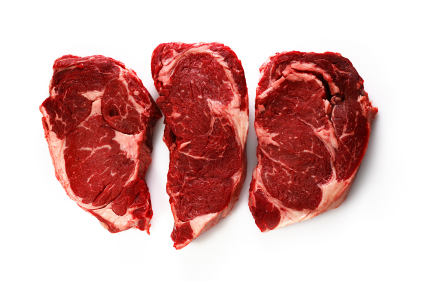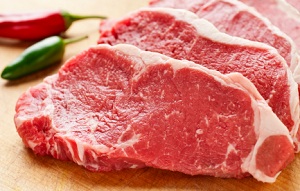By Anthoney J. Andersen – Steroidal.com
Does eating red meat actually increase the risk of dying from heart disease or cancer?
It’s a question that continues to sprout up among nutritionists and health enthusiasts alike.
So, let’s take a closer look at some of the positive and negative health effects that red meat can have on the body.
MEAT ISN’T WHAT IT USED TO BE
Red meat has been around since the dawn of man, which means our digestive system is clearly furnished to handle it.
Traditional populations like the Inuit and Masai have consumed large quantities of red meat – much more than the average Westerner – but always managed to remain in excellent health [1].
However, the meat that we eat today is expansively different than the meat our ancestors ate. Back in the day of the caveman, animals fed on the grass of the land; insects or whatever came naturally to them.
Take a moment to picture a wild cow on a grassy field 10,000 years ago feeding on grass and other plant-like products.
Now, take a moment to consider how cows are raised today: born and raised in a factory, fed grain-based feed, then injected with a series of antibiotics and hormones to advance the growth of the animal.
Today, some of the meat we consume goes through even more processing after the animals are slaughtered – smoked, cured, then treated with nitrates, preservatives and other various chemicals, for example.
Before you go reaching for that delicious New York steak, first distinguish between the different types of meat:
- Processed meat: These products are usually derived from traditionally raised cows, and then go through diverse processing methods. Examples of this are sausage and bacon.
- Conventional red meat: This type of meat is fairly unprocessed, but the cows are usually factory farmed. Meats that are red when raw are defined as “red” meats, according to WebMD. Examples of this are lamb, beef and pork.
- White meat: Meats that are white when cooked are defined as “white” meat. Examples of this are chicken and turkey.
- Grass-fed, organic meat: This meat comes from animals that have been naturally fed, raised organically and have not been pumped full of drugs and hormones.
Even though red meat tends to garner a bad rep, it still is one of the most nutritious foods you can eat.
Red meat is chalked full of vitamins, minerals, antioxidants and other various nutrients that can have an acute effect on your health.
According to Mayo Clinic, a 100-gram (3.5 ounces) portion of raw ground beef (10 percent fat) contains the following:
- Vitamin B3 (Niacin): 25 percent of the Recommended Dietary Allowance (RDA).
- Vitamin B12: 37 percent of the RDA.
Keep in mind that this vitamin is unattainable from plant foods.
- Vitamin B6: 18 percent of the RDA.
- Iron: 12 percent of the RDA. This is high quality iron, which is absorbed at a higher rate than iron obtained from plant–based foods.
- Selenium: 24 percent of the RDA.
These portions stem from a calorie count of 176, with 20 grams of quality protein and 10 grams of fat.
Red meat is also flushed with other important nutrients like creatine and carnosine – nutrients that can add to the increase in muscle mass.
The bodies of non-meat eaters are often depleted of these nutrients, which can have negative effects on various aspects of health, which may include muscle and brain function [2].
Grass-fed beef can be even more nutritious than grain-fed, containing plenty of heart healthy Omega-3s, the fatty acid CLA, along with vitamins A & E [3].
GIVE ME STRENGTH OR GIVE ME DEATH
The health effects of red meat have been studied intensively in the last few decades.
However, the evidence obtained from these studies can’t officially generate certainty when it comes to the correlation between heart disease and red meat – they’re merely observational studies at best.
In a colossal review of 20 studies that included a total of 1,218,380 individuals, processed meat was associated with an increased risk of cardiovascular disease and diabetes.
However, no association was concluded for unprocessed red meat [4].
The observational studies seem to link processed meat – not processed RED meat – to an increased risk of an early death and many diseases.
CONCLUSION
When you gaze past all the hype and overblown headlines created by the media, you realize that along with most things in life, red meat is like anything else: it can be beneficial, but also acquires the ability to cause harm if abused.
And since there are no controlled trials linking red meat to harmful diseases – only observational studies – the only thing you can do for yourself is consume red meat in moderation in order to keep your body on the safe side of the health spectrum.
Red meat contains many vital nutrients that your body needs to function properly.
Not to mention, it tastes spectacular.
Stay healthy.
References:
[1]. “Cardiovascular Disease in the Masai.” 1964. July. 8. Journal of Atherosclerosis Research.
[2.] “Effect of Creatine and Weight Training on Muscle Creatine and Performance in Vegetarians.” 2003. November. 3. National Institutes of Health.
[3]. “Fatty Acid Profiles and Antioxidant Content in Grass-fed and Grain-fed Beef.” 10. March. 2010. Nutrition Journal.
[4]. “Red and Processed Meat Consumption and Risk of Incident Coronary Heart Disease.” 2010. June. 1. National Institutes of Health.








